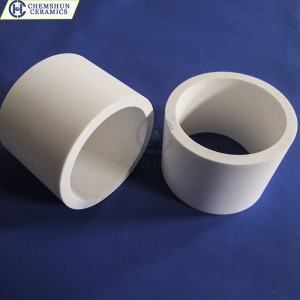Wear-resistant ceramics are widely used in many fields such as industrial production, machinery manufacturing, and mining due to their excellent wear resistance, high hardness, and good chemical stability. However, even wear-resistant ceramics with excellent performance may degrade or even be damaged due to various factors during long-term use. In order to maximize the service life of wear-resistant ceramics, the following are practical suggestions from multiple aspects:
1. Control the use temperature
The performance of wear-resistant ceramics is greatly affected by temperature. Exceeding its allowable operating temperature range may cause changes in internal stress of the material, structural damage, or performance degradation. When using, strictly follow the temperature range in the product manual.
In high temperature environments, consider adding a cooling system or choosing wear-resistant ceramic materials with better high temperature resistance. In addition, check the temperature of the equipment regularly to ensure that it operates within a safe range.
2. Reasonably adjust the voltage
For wear-resistant ceramic equipment that requires electric drive (such as some electric grinders), the stability of the voltage directly affects its working efficiency and life. Using a stable power supply can avoid excessive voltage fluctuations; adjust to the optimal working voltage according to the equipment requirements to avoid long-term overload operation. Check the electrical system regularly to ensure that the connection is good and there is no short circuit or leakage.
3. Avoid overloading
Overloading will accelerate the wear of wear-resistant ceramics and shorten their service life. According to the design parameters and instruction manual of the equipment, arrange the workload reasonably to avoid long-term continuous work; regularly evaluate the load of the equipment, upgrade or replace more suitable equipment when necessary, and establish a regular maintenance system to promptly detect and deal with potential overload risks.
4. Reduce collision and impact
Collision and impact are one of the common causes of damage to wear-resistant ceramics, especially under high-speed operation or complex working conditions.
- Take shock-absorbing measures during design and installation, such as installing buffer pads and using elastic connectors.
- Train operators to improve their proficiency and accuracy in equipment operation and reduce collisions caused by misoperation.
- Regularly check the equipment fixings and connecting parts to ensure that they are reliably fastened to prevent looseness and accidental impact.
5. Regular cleaning and maintenance
Keeping the surface of wear-resistant ceramics clean can effectively prevent increased wear and performance degradation caused by dirt accumulation.
Implementation measures
- Develop a cleaning plan to regularly clean the surface of wear-resistant ceramics to remove attached impurities and particles.
- Use appropriate cleaning agents and tools to avoid using substances that may damage the ceramic surface.
- Check and replace seals and wearing parts that are severely worn to prevent them from affecting overall performance.
In summary, by controlling the operating temperature, adjusting the voltage reasonably, avoiding overload use, reducing collisions and impacts, regular cleaning and maintenance, preventing chemical corrosion, and properly storing and keeping, the service life of wear-resistant ceramics can be significantly extended, maintenance costs can be reduced, and production efficiency can be improved.
Post time: Aug-10-2024


